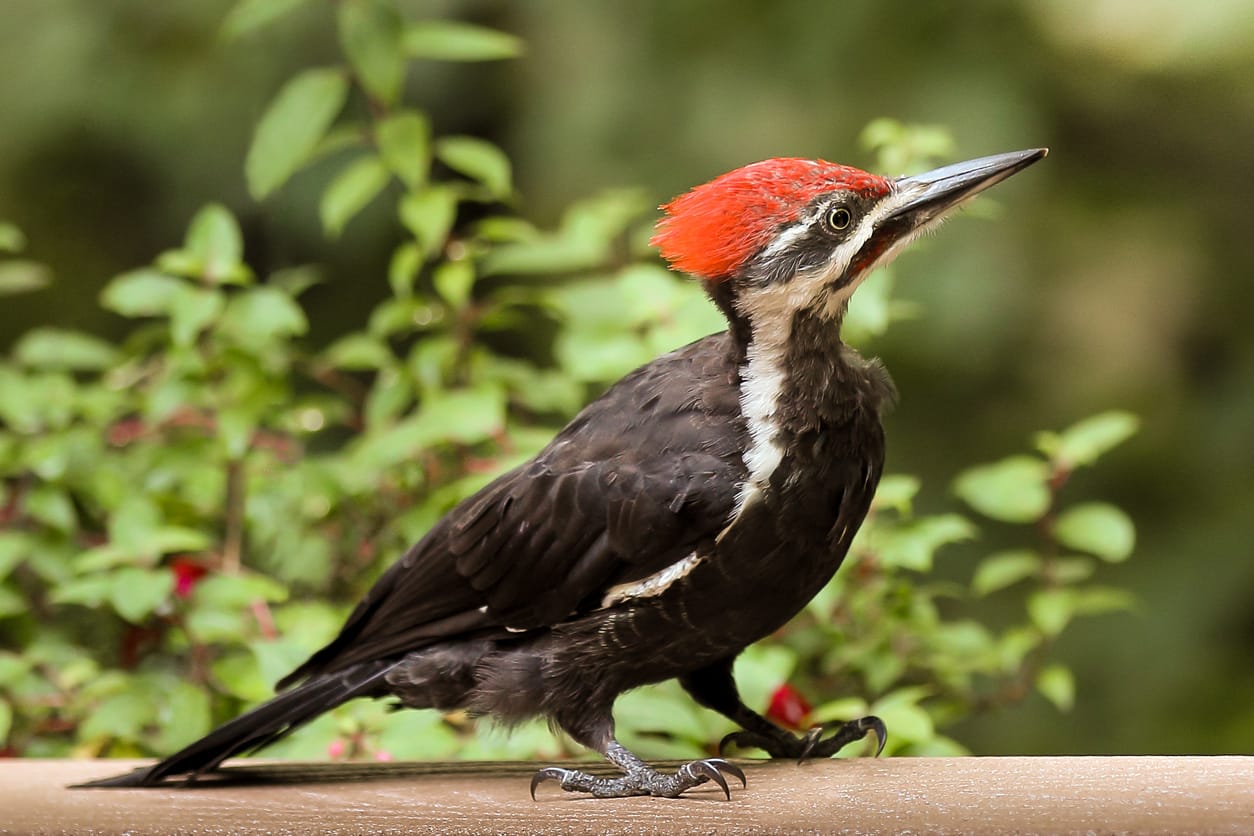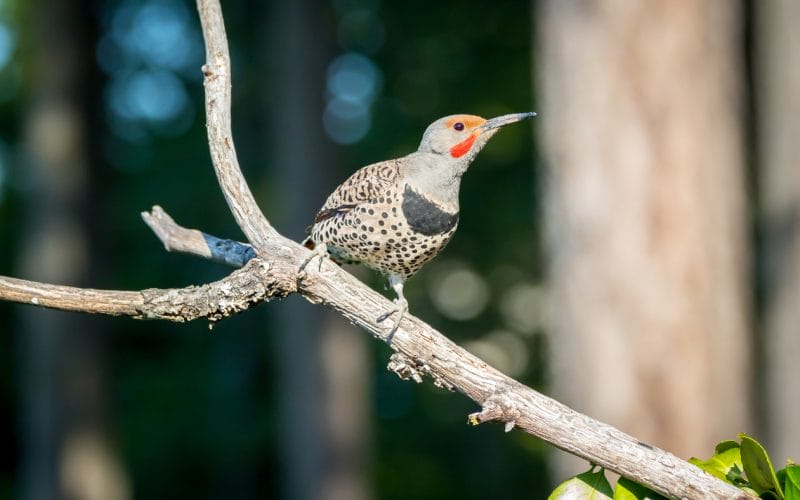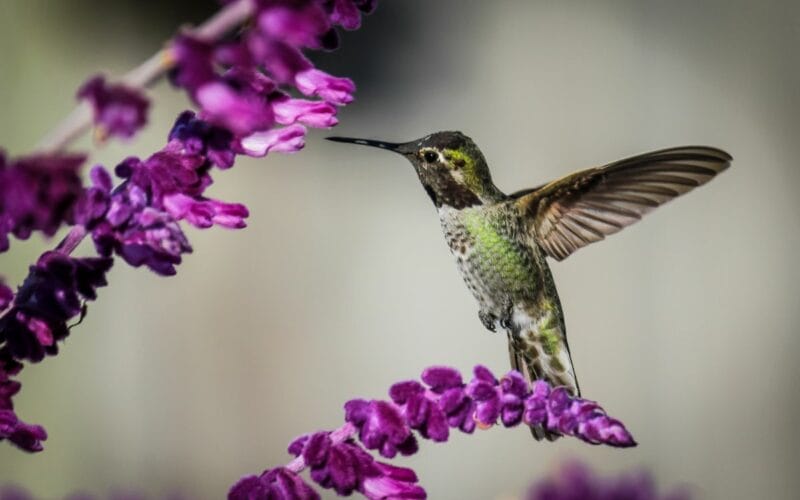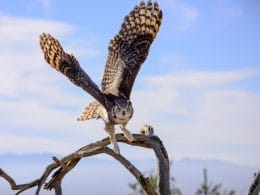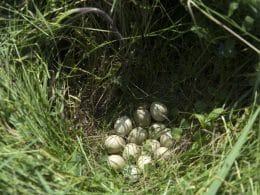Tennessee has an impressive range of wildlife thanks to its exceptional geographic standpoint. It houses the Unaka Mountains and other high peaks like the Clingman’s Dome and the Great Smoky Mountains National Park.
With all of Tennessee’s forestry, you can expect to find a myriad of ecosystems!
There’s no shortage of woodpeckers in Tennessee. In fact, you can find eight different species of woodpeckers there. Most of these tree-loving birds enjoy an all-year-long stay in Tennessee.
Stick around to learn more about woodpeckers in Tennessee as well as where and how you can spot them.
8 Woodpeckers in Tennessee
In your birdwatching walk, always put your ear out for that tell-tale drumming noise. Some of these woodpeckers will be easy to listen to, while others might be a bit tougher to spot.
1. Red-Bellied Woodpecker
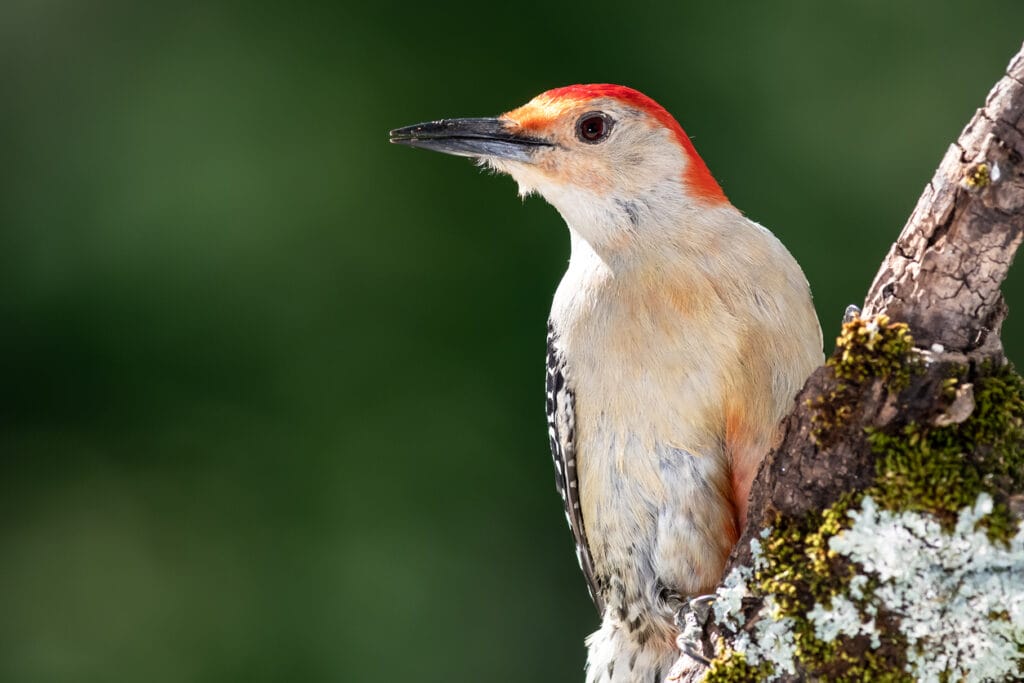
- Scientific name: Melanerpes carolinus
- Length: 9 to 10.6 inches
- Weight: 2.5 oz.
- Wingspan: 15 to 18.1 inches
If you’re trying to spot these woodpeckers, you wouldn’t need to look for a crimson red belly. Despite what their name suggests, Red-bellied Woodpeckers have only a tinge of red under their belly that almost looks more peach.
They’re more noticeable from their black and white patterned wings and red-striped heads. Other than that, Red-bellied Woodpeckers have light-colored bellies and necks as well as black sharp beaks.
These woodpecker species are usually found in woodlands along the Eastern side. You can try to attract them with some backyard suet feeders. They’ll fly right in, especially if you reside near forests.
Author Note: Unlike most other woodpeckers, the red-bellied species isn’t too keen on pecking for insects in trees. They prefer foraging for berries and seeds, as well as small birds and amphibians.
Red-bellied Woodpeckers are likely to be found perched on a treetop branch. In some cases, they use their spiked beaks to graze off the wood from the trees and look for insects.
Listening to them won’t be difficult since they give off a high-pitched shrill and loudly drum their beaks for approximately 19 beats each second.
2. Pileated Woodpecker

- Scientific name: Dryocopus pileatus
- Length: 16 to 19 inches
- Weight: 8.8 to 14.1 oz.
- Wingspan: 11.8 inches
You’ll want to take out your camera for this woodpecker. Pileated Woodpeckers are famously the largest of their kind in North America. For a size comparison, they’re similarly proportioned to a crow.
That being said, these woodpeckers’ size might not be the first characteristic you’ll notice when first spotting them. You might be too busy staring at their flaming pointy redhead.
Pileated Woodpeckers have distinct patterns on their faces as well. Their eye area is black-masked with a white stripe just under it that runs along the sides of its neck.
The rest of their bodies are mostly black. Pileated Woodpeckers’ beaks are black-striped and rugged.
Speaking of their sturdy beaks, Pileated Woodpeckers’ bills can penetrate through small trees. Yes, they can chop up a tree in half.
They don’t just randomly dig; instead, they form a rectangular cavity to ease their search for their favorite snack, insects.
Other birds like to benefit from Pileated Woodpecker’s work and often freeload on their digging sites to catch some insects for themselves. Birds like owls and ducks often use these cavities for shelter as well.
Like the Red-bellied Woodpecker, the pileated species are also found on the Eastern side of the U.S. You can also entice them into your backyard with a suet bird feeder.
With such a large body, you can expect Pileated Woodpeckers to make an equally large drumming sound. Their ear-piercing calls almost sound like laughter or a “wuk-wuk-wuk.”
3. Northern Flicker
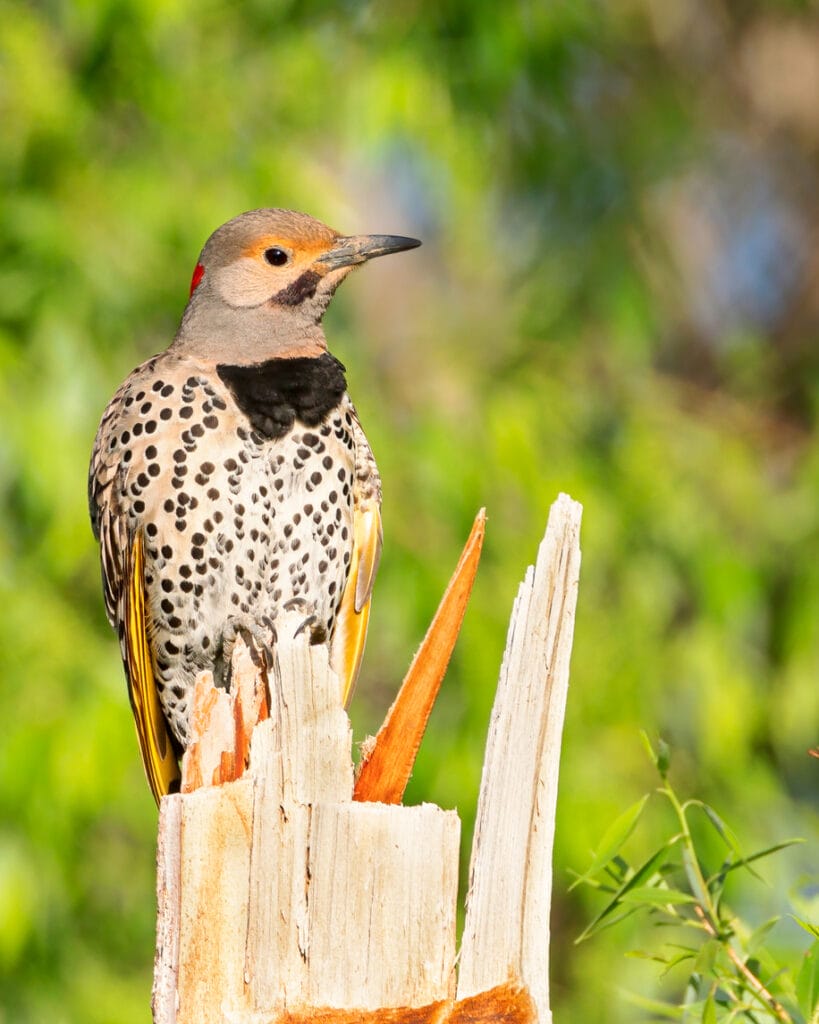
- Scientific name: Colaptes auratus
- Length: 11.8 to 13.8 inches
- Weight: 3 to 5.9 oz.
- Wingspan: 21.3 inches
Northern Flickers expand beyond Tennessee and can be found in the majority of the U.S. Nevertheless, they can be differentiated depending on which side they hail from.
For instance, Western northern flickers have red feathers in their wings, while Eastern Northern Flickers have yellow ones instead.
Top Tip: Northern Flickers like to look for their nutrient supplements on ground-level rather than on branches and treetops. Like anteaters, this woodpecker species likes to gorge on ants by sticking out its tongue to catch some.
If you hear Northern Flickers performing a drumming routine, it might mean that they’re attempting to communicate with their kind. They try to be as loud as possible. You might even hear them drumming on metal poles from over half a mile away.
Appearance-wise, Northern Flickers are stubby round woodpeckers. Their beaks are slightly curved downward and black. Their plumage is mostly covered in a light brown with black dots all over their chest.
Their eye area has a peachy tint while their heads are grey. Under their neck, northern flickers have a black half-circle. Although their colors aren’t so vibrant, they do have a bright red flick right behind their necks. It can also be found on their cheeks.
If you want Northern Flickers to come to your backyard, consider building them a nest box where they can stay during winter. You can also attach a birdbath or bird feeder to attract them. They’re more likely to fly in if you’re near woodlands.
4. Downy Woodpecker
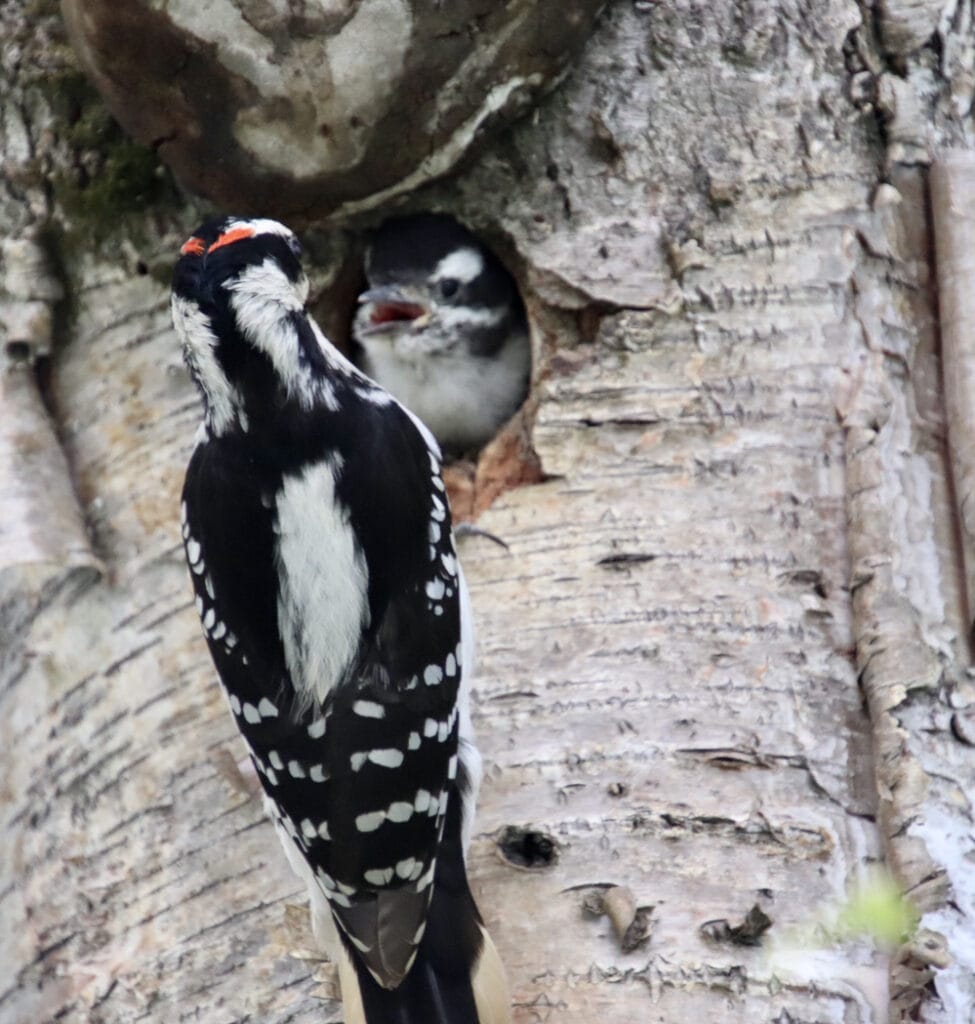
- Scientific name: Picoides pubescens
- Length: 5.5 to 6.7 inches
- Weight: 0.7 to 1 oz.
- Wingspan: 10 to 12 inches
Downy woodpeckers are among the smallest of their kind on this list. These adorable little peckers have an intricate black and white pattern on their neck and back. Their wings are black-coated with white spots lingering around.
Meanwhile, their bellies are purely white. At the top, their heads are striped in black and white. Males characteristically have a vivid red streak near the back of their heads.
You can spot these birds in Tennessee all year round since they have a relatively large population covering the area.
Downy Woodpeckers can squeeze themselves into harder-to-reach areas that are rich in tiny insects such as larvae and worms. They also search for acorns, fruit, and seeds.
These woodpeckers are so small that you can even place a hummingbird feeder to attract them into your backyard. They even mingle with similarly tiny birds while feeding like nuthatches and chickadees.
If you’re an avid birdwatcher in search of a downy woodpecker, we highly recommend targeting them during their breeding season, which is in spring.
Not only will they be more populous, but they’ll be louder as well. They often call out with shrill “chip” noises and loud drumming noises.
5. Yellow-Bellied Sapsucker

- Scientific name: Sphyrapicus varius
- Length: 7.5 to 8.3 inches
- Weight: 1.6 oz.
- Wingspan: 13.4 to 15.7 inches
True to half of their name, Yellow-bellied Sapsuckers enjoy using their tiny beaks to suckle on some tree sap. What about the first half of their name? Well, not so much. These woodpeckers’ bellies aren’t nearly as starkly yellow as you’d hope.
Instead, they’re yellow-hued with a mostly white belly. Yellow-bellied sapsuckers’ bodies are black and white with a striped pattern on the head and a dotted one on their backs.
Top Tip: Both male and female Yellow-bellied Sapsuckers are adorned with a vibrant red patch on their foreheads and throats.
That being so, these woodpecker species are talented at extracting sap from maple trees and other sap-producing trees. They drill a fine horizontal line along the bark to allow the sugary goodness to seep out.
Various insects may get stuck in the sap, so it’s like an added protein bonus to their tasty meal. You’ll most likely spot sapsuckers during winter since they migrate to breed in the north.
Trying to tempt a Yellow-bellied Sapsucker into your backyard can be tricky. They usually aren’t drawn to backyard feeders, but you can always try your luck with suet.
These woodpeckers emit a similar sound to a meowing kitten. They’re drumming sounds are also unique since they’re inconstant. If they’re guarding their territory against other birds, you might hear them drumming on metal poles.
6. Red-Headed Woodpecker
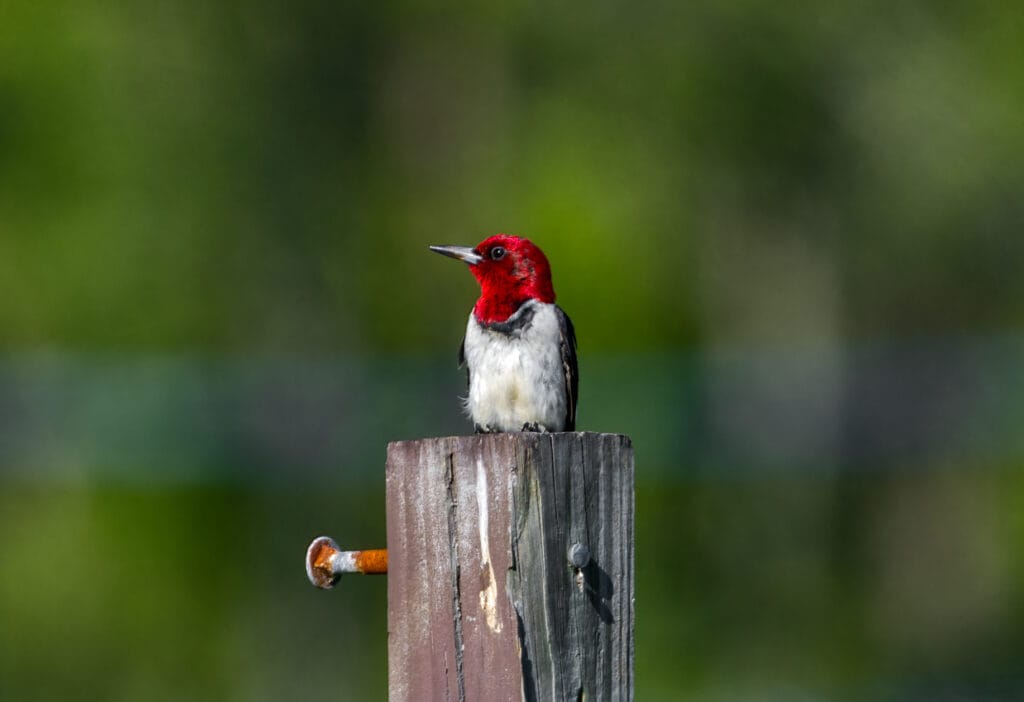
- Scientific name: Melanerpes erythrocephalus
- Length: 7.5 to 9.8 inches
- Weight: 2.4 oz.
- Wingspan: 14 to 17 inches
Red-headed Woodpeckers carry lots of history. During the 1700s, it sparked a birding interest in popular ornithologist, Alexander Wilson.
This woodpecker was also mentioned in Cherokee Indian culture as a powerful symbol of war. The Red-headed Woodpecker can span an older history. Fossils of this species were located in Virginia, Florida, and Illinois.
These remnants can be traced back to the Pleistocene age, which was around two million years ago. With such an extensive history, red-headed woodpeckers have undoubtedly distinctive features.
Their heads are fully red and complete with a dark grey beak and black beady eyes. Red-headed Woodpeckers have white bellies along with black upper wings and white lower wings.
You might be wondering how this woodpecker has survived numerous generations. Well, they’re one of the only woodpecker species to save their food for later consumption.
It keeps its uneaten food, which mostly includes insects, in dug-up tree bark, below roof shingles, and near fences.
Their hunting style is also impressive. Red-headed Woodpeckers can catch their insect prey in mid-flight. Not only do the woodpeckers sustain themselves with insects, but they also feed on nuts, fruits, seeds, and sometimes even lone bird eggs.
Red-headed Woodpeckers let out crow-like cackles. Similar to a Downy Woodpecker, they let out a series of drums accumulating to 19 beats every second.
7. Hairy Woodpecker

- Scientific name: Leuconotopicus villosus
- Length: 5.5 to 10.2 inches
- Weight: 0.7 to 1 oz.
- Wingspan: 15 inches
Hairy Woodpeckers are an ideal example of why these kinds of birds are vital in our ecosystem. They naturally feed on agricultural pests to keep crops healthy. You can spot them in dense woods, swamps, parks, and even cemeteries.
Hairy Woodpeckers bear a striking resemblance to Downy Woodpeckers since they have similar black and white striped, red-streaked heads, and dotted backs. The main difference between them is that hairy woodpeckers are slightly larger.
Top Tip: If you’re trying to spot a Hairy Woodpecker, try to keep your ears peeled for a “squeak.” They also whinny and make rattling noises. When it comes to their drumming speed, they can peck up to 26 beats per second.
The good news is that Hairy Woodpeckers are usually around all year long in Tennessee. The largest population of the woodpecker species can be spotted near the southwestern side of the state.
8. Red-Cockaded Woodpecker

- Scientific name: Leuconotopicus borealis
- Length: 7.8 to 9.1 inches
- Weight: 1.4 to 2 oz.
- Wingspan: 14 inches
Red-cockaded woodpeckers aren’t as plentiful as they once were. They’re one of the hardest woodpeckers to look for in Tennessee. The last one was seen in 1994 at the Cherokee National Forest.
Since they’re small, it makes them more difficult to spot. Even though its name suggests a red cockade, you can barely notice the red spot near their cheeks.
Like the Hairy and Downy Woodpeckers, the Red-cockaded Woodpecker is also covered in black and white striped plumage.
The woodpeckers enjoy communicating in social groups and searching for their food together. Their diet mostly consists of insects, berries, and seeds.
If you’re hoping to get a real-life look at a Red-cockaded Woodpecker, then you might want to visit a wildlife conservation refuge or a national park. These areas house endangered bird species to protect them from extinction.
To Conclude
Woodpeckers are delightful creatures. Not only are they pleasing to watch, but they’re crucial to the environment. They play a large ecological role in maintaining invasive insect populations.
Their drilled holes are also helpful to other animals to provide them with insects to feed on and shelter. Tennessee’s large collection of various woodpecker species is enough to make any birdwatcher satisfied.
From Pileated Woodpeckers to Yellow-bellied Sapsuckers, each bird has its special characteristics. We advise watching these mesmerizing creatures from afar or using backyard feeders and birdbaths to draw them in for a quick meal, drink, or bath.
FAQ
As well as the places listed above, you could try these places: Tennessee National Wildlife Refuge, Meeman-Shelby Forest State Park and Brainerd Levee
To find out where recent sightings of woodpecker have been, try eBird. You can search for the latest sightings or particular species or what has been seen in a certain area.
According to state government records, it is the Pileated Woodpecker.




